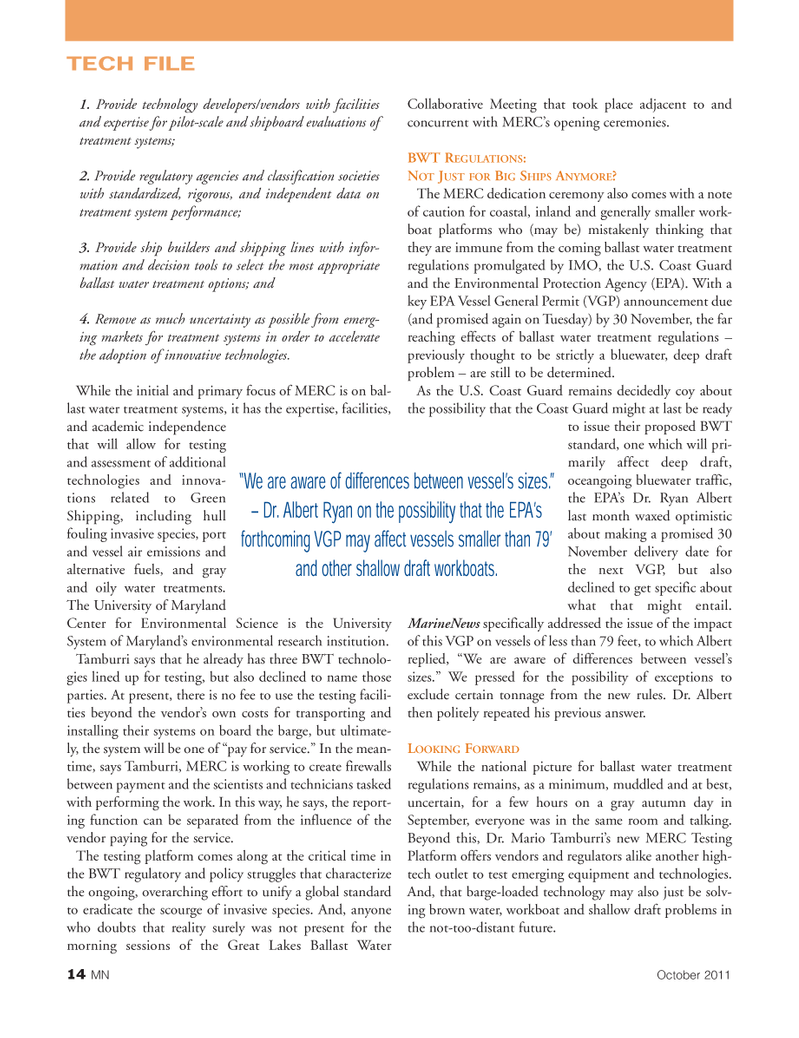
Page 14: of Marine News Magazine (October 2011)
The Yearbook
Read this page in Pdf, Flash or Html5 edition of October 2011 Marine News Magazine
14MNOctober 2011TECH FILE1. Provide technology developers/vendors with facilities and expertise for pilot-scale and shipboard evaluations of treatment systems; 2.Provide regulatory agencies and classification societies with standardized, rigorous, and independent data on treatment system performance; 3. Provide ship builders and shipping lines with infor- mation and decision tools to select the most appropriate ballast water treatment options; and 4. Remove as much uncertainty as possible from emerg- ing markets for treatment systems in order to accelerate the adoption of innovative technologies. While the initial and primary focus of MERC is on bal- last water treatment systems, it has the expertise, facilities, and academic independencethat will allow for testing and assessment of additionaltechnologies and innova- tions related to Green Shipping, including hull fouling invasive species, port and vessel air emissions and alternative fuels, and gray and oily water treatments. The University of Maryland Center for Environmental Science is the University System of Maryland?s environmental research institution. Tamburri says that he already has three BWT technolo- gies lined up for testing, but also declined to name thoseparties. At present, there is no fee to use the testing facili- ties beyond the vendor?s own costs for transporting and installing their systems on board the barge, but ultimate- ly, the system will be one of ?pay for service.? In the mean- time, says Tamburri, MERC is working to create firewalls between payment and the scientists and technicians tasked with performing the work. In this way, he says, the report- ing function can be separated from the influence of the vendor paying for the service. The testing platform comes along at the critical time inthe BWT regulatory and policy struggles that characterize the ongoing, overarching effort to unify a global standard to eradicate the scourge of invasive species. And, anyone who doubts that reality surely was not present for the morning sessions of the Great Lakes Ballast Water Collaborative Meeting that took place adjacent to and concurrent with MERC?s opening ceremonies. BWT R EGULATIONS : NOTJUSTFOR BIGSHIPSANYMORE?The MERC dedication ceremony also comes with a note of caution for coastal, inland and generally smaller work-boat platforms who (may be) mistakenly thinking thatthey are immune from the coming ballast water treatment regulations promulgated by IMO, the U.S. Coast Guard and the Environmental Protection Agency (EPA). With a key EPA Vessel General Permit (VGP) announcement due (and promised again on Tuesday) by 30 November, the far reaching effects of ballast water treatment regulations ? previously thought to be strictly a bluewater, deep draft problem ? are still to be determined. As the U.S. Coast Guard remains decidedly coy about the possibility that the Coast Guard might at last be ready to issue their proposed BWT standard, one which will pri- marily affect deep draft,oceangoing bluewater traffic, the EPA?s Dr. Ryan Albert last month waxed optimistic about making a promised 30 November delivery date for the next VGP, but also declined to get specific aboutwhat that might entail.MarineNews specifically addressed the issue of the impact of this VGP on vessels of less than 79 feet, to which Albert replied, ?We are aware of differences between vessel?s sizes.? We pressed for the possibility of exceptions to exclude certain tonnage from the new rules. Dr. Albert then politely repeated his previous answer. LOOKINGFORWARD While the national picture for ballast water treatment regulations remains, as a minimum, muddled and at best, uncertain, for a few hours on a gray autumn day in September, everyone was in the same room and talking. Beyond this, Dr. Mario Tamburri?s new MERC Testing Platform offers vendors and regulators alike another high- tech outlet to test emerging equipment and technologies.And, that barge-loaded technology may also just be solv-ing brown water, workboat and shallow draft problems in the not-too-distant future. ?We are aware of differences between vessel?s sizes.? ? Dr. Albert Ryan on the possibility that the EPA?s forthcoming VGP may affect vessels smaller than 79? and other shallow draft workboats. MN#10 (1-17):MN 2011 Layouts 10/5/2011 1:30 PM Page 14

 13
13

 15
15
